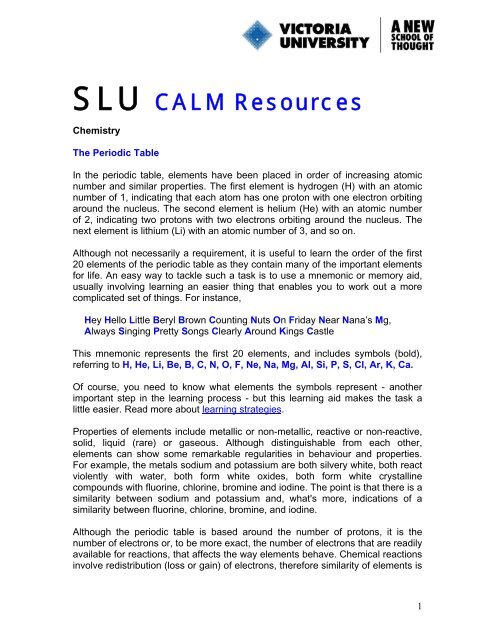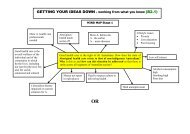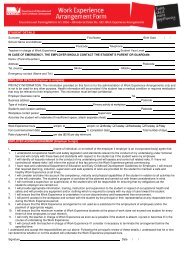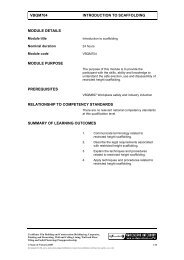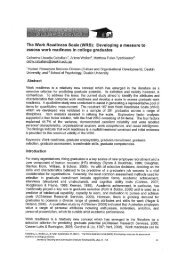Create successful ePaper yourself
Turn your PDF publications into a flip-book with our unique Google optimized e-Paper software.
SLU CALM Resources<br />
Chemistry<br />
<strong>The</strong> <strong>Periodic</strong> <strong>Table</strong><br />
In the periodic table, elements have been placed in order of increasing atomic<br />
number and similar properties. <strong>The</strong> first element is hydrogen (H) with an atomic<br />
number of 1, indicating that each atom has one proton with one electron orbiting<br />
around the nucleus. <strong>The</strong> second element is helium (He) with an atomic number<br />
of 2, indicating two protons with two electrons orbiting around the nucleus. <strong>The</strong><br />
next element is lithium (Li) with an atomic number of 3, and so on.<br />
Although not necessarily a requirement, it is useful to learn the order of the first<br />
20 elements of the periodic table as they contain many of the important elements<br />
for life. An easy way to tackle such a task is to use a mnemonic or memory aid,<br />
usually involving learning an easier thing that enables you to work out a more<br />
complicated set of things. For instance,<br />
Hey Hello Little Beryl Brown Counting Nuts On Friday Near Nana’s Mg,<br />
Always Singing Pretty Songs Clearly Around Kings Castle<br />
This mnemonic represents the first 20 elements, and includes symbols (bold),<br />
referring to H, He, Li, Be, B, C, N, O, F, Ne, Na, Mg, Al, Si, P, S, Cl, Ar, K, Ca.<br />
Of course, you need to know what elements the symbols represent - another<br />
important step in the learning process - but this learning aid makes the task a<br />
little easier. Read more about learning strategies.<br />
Properties of elements include metallic or non-metallic, reactive or non-reactive,<br />
solid, liquid (rare) or gaseous. Although distinguishable from each other,<br />
elements can show some remarkable regularities in behaviour and properties.<br />
For example, the metals sodium and potassium are both silvery white, both react<br />
violently with water, both form white oxides, both form white crystalline<br />
compounds with fluorine, chlorine, bromine and iodine. <strong>The</strong> point is that there is a<br />
similarity between sodium and potassium and, what's more, indications of a<br />
similarity between fluorine, chlorine, bromine, and iodine.<br />
Although the periodic table is based around the number of protons, it is the<br />
number of electrons or, to be more exact, the number of electrons that are readily<br />
available for reactions, that affects the way elements behave. Chemical reactions<br />
involve redistribution (loss or gain) of electrons, therefore similarity of elements is<br />
1
eflected by the number of electrons which each element either gains or loses.<br />
<strong>The</strong> number of electrons is not constant because they may be redistributed from<br />
atom to atom during chemical reactions. This is why atomic number refers to the<br />
number of protons, not electrons.<br />
Thus, elements with similar properties have atoms that lose or gain the same<br />
number of electrons during chemical reactions. Elements are classified according<br />
to vertical groups (Roman numerals). <strong>The</strong>re are 8 main groups, namely groups I,<br />
II, III, IV, V, VI, VII, and 0 (sometimes called VIII). <strong>The</strong>se group numbers coincide<br />
with the number of electrons in the outer shell (energy level) of the atoms.<br />
Patterns also occur periodically, thus the table is arranged horizontally in periods.<br />
<strong>The</strong> <strong>Periodic</strong> <strong>Table</strong> - first 20 elements<br />
Groups<br />
Period I II III IV V VI VII 0<br />
1 H<br />
1<br />
He 2<br />
2 Li 3 Be 4 B 5 C 6 N 7 O 8 F 9 Ne 10<br />
3 Na 11 Mg 12 Al 13 Si 14 P 15 S 16 Cl 17 Ar 18<br />
4 K 19 Ca 20<br />
More information on the <strong>Periodic</strong> <strong>Table</strong>.<br />
Electron Shells (energy levels)<br />
<strong>The</strong> atomic theory suggests that electrons in atoms orbit around the nucleus at<br />
discrete set distances called electron shells. Each electron shell contains<br />
electrons with the same energy level. <strong>The</strong>re is a maximum number of electrons in<br />
each shell. <strong>The</strong> nearest shell to the nucleus can have up to 2 electrons, the<br />
second shell can have up to 8 electrons, the third shell up to 18 electrons, etc.<br />
<strong>The</strong> maximum number of electrons in the outer shell, however, is 8 which seems<br />
to be a very stable number chemically (as is 2).<br />
<strong>The</strong> elements of Group 0, the inert gases, appear to have such a stable outer<br />
layer of electrons that they do not easily react, if at all. <strong>The</strong>se elements all have 8<br />
electrons in the outer shell (except Helium, which has 2).<br />
2
Elements in other groups do not have the stable number of 8 elements in the<br />
outer shell. <strong>The</strong>se elements tend to be chemically reactive as electrons move to<br />
or from atoms. Chemical reactions result from the tendency of electrons to fill the<br />
outer shell to the most stable number (usually 8).<br />
<strong>The</strong>re is a strong chemical imperative towards a full outer shell, particularly in<br />
elements containing atoms that have close to a full shell of electrons. Groups I<br />
and VII contain elements that are amongst the most reactive in the periodic table.<br />
Group VII elements tend to gain one electron, resulting in a full outer shell. Group<br />
I elements tend to lose one electron, resulting in a full outer shell (but one less<br />
shell).<br />
3


